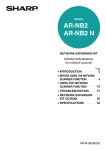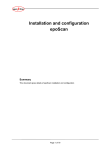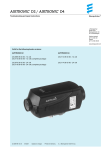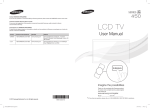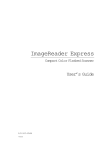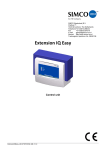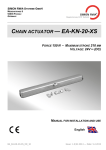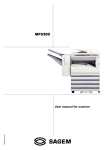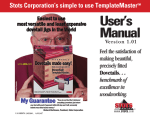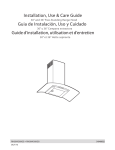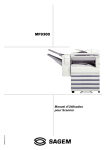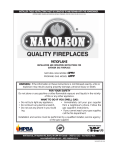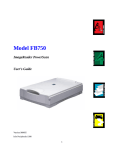Download IBM Ricoh ImageReader FB 2400 dpi User's Manual
Transcript
info 580 Division Street Campbell CA, 95008 Phone (408) 538-2500 Fax (408) 538-2599 Copyright C) 1996 All rights reserved. No portion of this document may be reproduced without prior written authorization. The Info Technician Copyright 1994, 1995, 1996 All Rights Reserved The material in this document is for informational purposes only and is subject to change without notice. The manufacturer assumes no responsibility for errors or omissions in this document, nor any damages resulting from the use of the information contained herein. Info and ImageReader are trademarks of Info Peripherals. Any other trademarks, registration marks, or brand names mentioned within this publication are the property of their respective owners. Tbble of Contents Chapter I Intr oduction Introduction welcome Using this manual Assistance ................................................................................... 1-1 What is TWAIN? ......................................................................... 1-2 A note about application software ................................. 1-2 Package contents System requirements PC and compatibles system requirements 1-4 Mac and compatibles system requirements 1-4 Chapter 2 Scanner Installation ......................................................................................... 2-1 PC and compatibles installation ......................................................................... 2-1 Installing the interface card ................................................................................ 2-1 Connecting the scanner ...................................................................................... 2-2 The Info Technician ............................................................................................ 2-2 Installing the device driver ................................................................................. 2-3 Mac and compatibles installation ....................................................................... 2-3 Scanner installation ....................................................................................... 2-3 Installing the driver ....................................................................................... 2-4 Installing the application software ..................................................................... 2-4 Chapter 3 Using yyour our scanner ........................................................................................... 3-1 Scanning features and controls ........................................................................... 3-1 Hardware features ....................................................................................... 3-1 Software controls ....................................................................................... 3-2 Scanning images ................................................................................................ 3-8 Select the IWAIN source (PC) ............................................................................ 3-8 The scanning process .......................................................................................... 3-9 Other scanning features .................................................................................... 3-10 Appendix A Troub leshooting ............................................................................................... A-I oubleshooting For PC and compatibles only ............................................................................ A-2 For Mac and compatibles only .......................................................................... A-2 Scanner careI ...................................................................................................... A-3 Limited two year warranty ................................................................................. A-4 FCC radio frequency interference statement ...................................................... A-5 LI Chapter I introduction welcome Thank you for purchasing an Info ImageReader Scanner. This product is the result of our efforts to develop high technology computer peripherals that are easy to use, affordably priced, and that enhance your computing experience. Using this manual This manual includes complete instructions for scanner installation, use, and maintenance. Note that “use,” in this context, refers to scanner operation independent of tasks performed in conjunction witl application software. This guide is organized in a “do as you read” format. For best results, perform the tasks as they are presented. This manual assumes that you have a basic understanding of the DOS and Windows operating system. As a convention, this guide presents all references to guide names or sections in italics, and commands you must type at a command line ent typeface. are presented in a dif difffer erent Assistance If you experience difficulties and cannot find solutions within this guide, contact Info’s Technical Support Department at (408) 538-2510, Monday through Friday, between 8:00 Am and 4:30 Pm, Pacific time. If you wish, you may fax questions to (408) 538-2577. Provide, a fax number for return contact. We maintain a BBS at (408) 538-2598 that contains the latest updates to our software, as well as a web site at infoconnection.com. If all of our technicians are occupied, please leave your name and phone number on our voice mail system. This system is intended to avoid excessive “on hold” waiting. You and your questions are important to us and we will respond as quickly as possible. After hours calls are returned the following working day. 1-1 Wha AIN? hatt is TW TWAIN? TWAIN is the interface that links the scanner with scanning software applications. -TWAIN is an industry standard that enables you to use the ImageReader with any TWAIN-compliant software application. With the introduction of Windows 95, the TWAIN specification bat been overhauled to take advantage of the 32-bit architecture. When you install our scanner driver under Windows 95, you will have two TWAIN sources - one for 16-bit applications and one for 32-bit applications. Use the following as a guide to select the appropriate source. 16-bit aapplica pplica tions are legacy Windows 3.x programs that you are running under Windows 95. pplications 32-bit aapplica pplica tions are programs specifically designed for Windows 95, to take advantage of performance enpplications hancements provided by the new architecture. You may experience scanning problems if you do not use the appropriate source. There is no change to the TWAIN source for Windows 3. 1 x users. Only the 16-bit TWAIN source is installed. tion softw A note aabout bout applica ar pplication softwar aree The scanner hardware by itself is not very useful. It takes a combination of the scanner hardware and application software to perform any task. Before you begin scanning, you need to choose the appropriate application to use for the task at hand. Please read this section to,gain an understanding of the types of scanning software there are. Scanning software generally falls into two groups, Graphics (image editing), or OCR (Optical Character Recognition). Each type has specific features designed to address the technical challenges faced in the scanning of graphics or of text. Graphics: Software in this category provide’s the user with image editing tools for performing extensive modifications to art, photographs, or other continuous tone images. While having the 1-2 ability to scan text, it is not designed to specifically identify individual characters as does OCR software. Any image scanned using a graphics program can only be saved in a graphics file format. It cannot be saved as an editable text file. OCR: Software in this category is designed to recognize alphanumeric characters in preparation for export to word processing and desktop publishing applications. In other terms, it creates text files. OCR software will not provide image editing capabilities. If there is no intention of editing a given piece of text (with or without graphics), it may be simpler to scan and save it as a graphic. Additional types of applications are available that offer solutions for special or unique tasks. These include document storage, form scanning, fax utilities, copy utilities, custom screen saver creation, photo album creation, and so on, If applications are intended to link directly to the scanning device, look for the TWAINcompliant specification. If compliant, they are compatible with Info ImageReader scanners. Pac ka ge contents acka kag Please verify that all materials have been received before setting up and using your scanner. The package contents are listed in the Quick Start Guide. System rrequir equir ements equirements System requirements are largely dependent on the “work” performed. By work, we are referring to the task or operation performed using the scanner in conjunction with application software. Because scanners are capable of inputting large amounts of data in relatively short periods of time, they commonly push computer systems to the limits of their capabilities. Before beginning any scanning task or operation, carefully consider your system’s processing capabilities, especially processor speed, RAM, and available hard disk space. OCR processes, fax operations, and the processing of simple black & white graphics are least demanding. High resolution scanning of large images in full color creates an extreme demand for processor time and memory. 1-3 When you are scanning with the TWAIN interface, the number labeled image size (calculated in bytes) provides the working file size that is the result of the selected scanning mode, resolution, and image size. Take careful note of this information. equir ements PC and compa tib les system rrequir compatib tibles equirements 386,processororlOO%co patible;486orhigherrecommended MS DOS 5. 0 or later with Windows 3.1 x, or Windows 95 or later 4 MB RAM; 8 MB or more recommended 25 MB available hard disk space; 50 MB recommended VGA/SVGA monitor with at least 256 color capability recommended Available 16-bit expansion slot Mac and compa tib les system rrequir equir ements compatib tibles equirements Macintosh with 68040 processor or greater System 7.0 or later 8 MB or more of RAM 4 MB RAM; 8 MB RAM recommended 1-4 Chapter 2 Scanner Installation PC and compatibles installation Installation of the scanner is comprised of few steps and designed to be as easy as possible. The following instructions walk you through installing the interface card into your PC, and connecting the scanner and cable. It is important to note that both the scanning hardware and its supporting software (e.g. Info Technician and the included applications) must be installed in order for the scanner to operate. Installing the interface card The installation of the scanner’s interface card is a simple process. Because your PC is designed with room for additional peripherals, the manual that was provided with your computer contains complete guidelines for case removal and expansion card installation. The graphic and instructions provided here are intended to supplement that information. Caution! As a safety precaution, the power to the computer and all peripheral equipment should be off and disconnected from the power source. Touch a grounded object before making contact with any components. Electrostatic discharge can damage the interface card and computer components. To install the interface card: I. Remove the computer’s housing. 2. On the computer’s mother board, select an available 16-bit ISA expansion slot, and remove its rear access cover. The slot must be free of dust and dirt to ensure a good connection. 3. align the gold-striped connector Hold the scanner interface card by the upper edge, and with the expansion slot. Press the card firmly into the slot as displayed in the diagram the next page. 4. Use the slot cover’s screw to retain the interface card. Replace the housing and secure all screws. 5. Reconne t the power source to your computer and any other peripheral equipment., Connecting the scanner If you have other SCSI devices installed on your system, set the scanner to a unique SCSI ID. Attach the 50-pin SCSI terminator block to the port on the scanner, and connect the SCSI cable to the terminator block. Place the scanner unit in the desired location, and route the interface cable to the computer in such a way as to assure it is safe from possible damage due to pinching or crimping. Insert the 25-pin male connector on the cable into the port on the interface card. The cable can only be inserted one way - do not force a connection. Connect the power cable as well. Once the scanner is attached and near the location you want it, unlock the scanning mechanism. The scanner is looked for transport to avoid damage to the assembly. You must unlock the scanner before you turn it on for the first time. Failure to do so may cause damage to the scanner, and will void your warranty. Simply turn the dial on the bottom of the scanner to the unlock position. The Inf o Tec hnician Info echnician The Info Technician is an automatic installation utility that edits and installs the scanner’s device and TWAIN drivers. These drivers provide the link between the scanning hardware, the scanning application, and the computer’s operating system. 2-2 Installing the de vice dr device driiver Run the Info Technician to install the scanner drivers. To do so: 1 . Insert disk 1 of the Info Technician into the computer’s floppy drive. 2.In Windows Program Manager, select the Run command from he File menu. If you are using Windows 95, select Run from the Start menu on the desktop. 3. Type A:\SETUP at the command line and click OK. Substitute the appropriate drive letter if the disk is not in the A drive. 4. Follow the on screen directions. The scanner’s device driver is installed in the proper directory, along with the TWAIN driver. 5. Reboot the computer after the installation is complete to activate the scanner drivers. Mac and compatibles installation The ImageReader FB is capable of running on a Macintosh or Mac compatibles as well as PCs. If this unit shipped with Mac software and a plug-in driver (not all models do), read this section for instructions about installing this scanner on your Mac system. Scanner installation Set the scanner to a unique SCSI ID. Attach the 50-pin SCSI terminator block to the port on the scanner, and connect the SCSI cable to the terminator block. Pace the scanner unit In the desired location, and route the interface cable to the computer in such a way as to assure it is safe from possible damage due to pinching or crimping. Insert the 25-pin male connector on the cable into the SCSI port on your Mac, or the last device on your chain. The cable can only be inserted one way - do not force a connection. Connect the power cable as well. Once the scanner is attached and near the location you want it, unlock the scanning mechanism. The scanner is locked for transport to avoid damage to the assembly. You must unlock the scanner before you turn it on for the first time. Failure to do so may cause damage to the scanner, and will void your warranty. Simply turn the dial on the bottom of the scanner to the unlock position. Turn on the scanner, then start-up your system. Installing the dr driiver This scanner interfaces with your Mac software through a Plug-in driver. You can use this scanner with any program that is Plug-in Module (PIM) compatible. To install the Plug-in driver: 1 . Insert the Plug-in disk into the floppy drive. 2. Double-click the disk icon if it is not already open. 3. Double-click the English folder to open its contents. 4. Locate the plug-ins folder for the application (i.e. PhotoDeluxe) you will be using to scan. Drag the plug-in module from the English folder on the disk to the application’s plug-ins folder. That application can now be opened and used with the scanner. The scanner plug-in should display on the Acquire list in the File menu. The ImageReader FB can also simulate an Apple scanner. This “Works Like Apple” driver is to be used with OCR programs, like OmniPage and TypeReader, that do not support PIM. Simply drag the “Works Like Apple” driver into your system folder and restart. When you are ready to use the OCR program, configure it for Apple Scanner or AppleOne Scanner. You can now use the scanner for OCR processes. Installing the aapplica pplica tion softw ar pplication softwar aree When the hardware and device driver software are installed, install the application software as described in their respective manuals. The Quick Start Guide also contains information about installing these programs. 2-4 Chapter 3 Using your scanner Scanning ffea ea tur es and contr ols eatur tures controls Before scanning images, it is important to understand the scanners basic hardware features as well as the software controls. Har dwar ea tur es Hard aree ffea eatur tures Power This scanner requires its own power source (use the cable provided), and there is an on/off power switch on the unit. Always turn the scanner on before you turn the computer on. This allows the computer to “see” the scanner when it is booting up. Indicator Ughts When you turn the scanner on, the Power indicator is lit. This light remains lit as long as power is provided to the scanner. When first turned on, the scanner performs a Power On Self Test (POST) diagnostic. The Ready indicator flashes during the POST diagnostic, then should remain steadily lit. If the scanner fails the POST diagnostic, or encounters a problem with use, the Ready indicator remains flashing. Refer to the Appendix for tro ulotestlooting information. Paper loading Place the document to be scanned face down on the scanning glass. Books, magazines and other 3climensional objects can be easily scanned as well, by laying them on the scanning glass., With bound materials and other objects, the cover Is designed to lift up at the hinge to accommodate the item being scanned. Do not force the cover down when scanning these items, it may break or scratch. Paper siz sizee The scanner will handle documents ranging in size from- a postage stamp to a legal size document (8.14" x 14"), including A4. Paper condition If the sheet to be scanned has any of the following conditions, please take the following precautions before scanIning. · * · Remove paper clips, pins or staples Let wet paper dry first Avoid scanning documents with correction fluid (dry or otherwis This avoids scratching or marring the scanning glass, and ensures years of beautiful scans. Softw ar ols Softwar aree contr controls The Info Technician loads a TWAIN-compliant driver. This driver functions as a “user interface” linking the scanning hardware and application software. Scanning is initiated from within the’apprication software. All scanning activities are controlled from the user interface window titled Info Peripherals Scanner. The interface window’s Prescan command is used to adjust the scanning area, contrast, and intensity before executing the actual “working” scan. The actual scan is then placed into the application software for viewing, editing, printing, or storage. In this section, the components and controls of the scanning interface window are explained. Pr w Windo w Preevie view indow The interface window’s right side displays Prescan images. The Crop Box around the perimeter is used to select the area you want to scan. Position the pointer over a square, click, hold, and drag the border to adjust the scanning area. The slider bar on the vertical ruler is also a convenient tool. This slider tells the scanner how far down the page to scan. You can shorten the time it takes to prescan by adjusting this slider to 11" when scanning letter size documents. Scan Mode Your scanning mode options are True Color, Gray Scale, and Bi-tone. These selections indicate the amount of data you want to capture for the image. Follow these guidelines when selecting a scan mode: True Color: Scan color images and photographs in True Color mode when you want to capture and reproduce all the color data. To manage file sizes efficiently, take careful note of the guidelines for resolution (described later) when scanning in True Color. The combination of True Color and a high dpi can create an extremely large file size. Gray Scale: What is referred to as black and white photographs are actually gray scale images. Different shades of gray are used to make up the whole picture. When you scan these types of images, you want to scan using the gray scale mode. Also use this mode to convert color photographs to black and white. Scanning a color photograph in gray scale will capture the continuous tones. Bi-tone: This mode captures black and white only. -Use this rnode when scanning single color (usually black) images, such as drawings or sketches, business logos, or text. This mode is also used when scanning a document you want to OCR. Resolution Resolution is measured in dots per inch (dpi). The higher the resoluton is set, the more detail in your image is captured. There are some guidelines you should follow when determining the resolution to scan at. They are detailed on the following page. 3-4 Z On-line graphics: If you are scanning an image to be used orim-line, such as the Internet, a BBS or in a multimedia presentation, you ne,odn’t scan any higher than 100 dpi. This is because a monitor’s resolution is either 72 dpi (Mac), or 96 or 120 dpi (PC), and is not capable of displaying a higher resolution. Images scanned at 300 dpi and viewed on a monitor will appear three times as large as the actual image. This enlargement results because your monitor displays images in a 1: 1 ratio of pixels (or dots), meaning one dot in the image equals one dot on-screen. At 300 dpi, the image contains 3 times as many dots when displayed on the monitor. Faxing images: Any image you intend to fax from a PC-based fax modem should be scanned at 200 dpi. Fax machines only receive images at 200 dpi, and some programs may fault if you try to scan at higher resolutions. Printed images: If you plan to print the images you scan, use the following table to select a resolution when scanning in color and gray scale. As a general rule, scan at twice the Line Screen Frequency of the output device. This information can be found in your printer’s manual. When scanning in line art mode, scan at the resolution of your printer, usually 300 or 600 dpi. This avoids sizing distortions in your printed images. Output De vice Device Line Scr een Scanning Resolutions Screen Frequencies Line Ar Artt Laser Printer (300 dpi) 50 dpi)50 300 120 Laser Printer (600dpi) 85 600 170 1200 210 Laser Printer (1200 dpi) 105 dpi)105 Imagesetter Color DySub Printer var ies Printerv aries 133 2400 match Color 266 2x line scr een screen Scaling Use the checkbox to toggle between proportional (set width and height individually) and integrated (set width and height together) scaling. Enter a percentage in the text box or use the slider bar to change the scaling values. 3-4 Flip This command creates a mirror image of the item scanned. In ver se Inv erse This command reverses an image’s display. Black pixels will be white, and white pixels will become black. The resulting image is like a photo negative of the original. Brightness and Contrast These controls adjust the brightness and contrast of the image you are about to scan. Increasing the contrast will sharpen the image, but cause it to look dark. Increase the brightness to lighten the image and compensate for the contrast selection. Experiment with these controls to determine the look you prefer. Usually these controls are adjusted together in a 2:1 ratio of brightness to contrast. Cur ves Curv The curves function allows you to alter the way different pixel values in your image are adjusted. The diagonal line shows a Gamma function of input to output pixel values. The default is a straight line, which makes no adjustments to the pixels. All the pixels that fall below the line are darkened, and those above the line are lightened. The four buttons in the lower left corner make automatic adjustments for types of images and documents. Use the lower right button for hazy images, the upper right button for high contrast images, and the lower left button for normal images. The upper left button restores the curve to its default setting. Le vels Lev This function displays a histogram of the number of pixels in the image with different values (representing different colors). The left side represents black, and the right side represents white or solid colors such as red, green or blue. The histogram is then broken into 256 channels. The left and right numbers above the histogram show the channel numbers, and the middle number expresses the ratio of channels to the left and to the right of the middle triangle below the histogram. The shaded slider bar beneath the histogram is the output level control. Slide the left and/or right triangles inward to give you more channels in regions where pixels are grouped in greater 3-5 ------------- numbers. This will produce an image with greater clarity. If you wish to expand one part of the histogram, rike where there are a large grouping of pixels, move the middle triangle toward that part. Since there are always 128 channels between the middle triangle and the end point triangles, adjusting them closer together gives the pixels in that region more channels to work with, and maximize the detail captured. Color Balance This control allows you to improve the look of your image, while retaining the detail as you adjust the color levels in the shadows, midtones and highlights. Shadows effects the dark pixel values of the image, midtone effects the middle range, or dominate range, of pixels, and highlights effects the light pixel values. Hue and Saturation This function enables you to change the hue and saturation of your images. Hue distinguishes one color from another, and by using the hue slide bar, you can adjust the hue angle by shifting the color on the spectrum. Saturation refers to the purity of color, and by adjusting the saturation slide bar, you can make the color look more vibrant and intense, or dull and gray, Lightness controls the amount of light acting on the color, and by using the slide bar, you can make the color lighter or darker. Monitor Gamma (PC) This control allows you’to change the gamma in your color images. If the color is off balance in your image, you can use this control in conjunction with the other image adjustments to get the image just right. Use the slider bar to increase or decrease the gamma. Default This button restores the image adjustments to their original settings. The prescan image is also restored to its unaltered appearance. Automa tic utomatic This function boost the image adjustments to maximum settings and fill the entire spectrum, causing the image to become more vivid. Bac kg Backg kgrround (Mac) Check this box to enable scanning in the backgroud while you do other work. This mimics true multitasking, however scanning speed is slowed considerably. w Pr Preegcan Vie iew Check this item to restore the prescan image to its unaltered appearance with out resetting the image adjustments. Original Scan Media Select which media you are scanning. Reflective is pieces like photographs, documents, magazines, etc., and indicates items will be placed on the scanning glass. Feeder enables use of the optional document feeder if you have one attached. Transparency enables you to scan negatives, x-rays, slides, etc., if you have the optional transparency adapter. Dither You can select this option when scanning in bi-tone mode. Use a variety of patterns to simulate gray scale in a black and white image. Inf or ma tion Infor orma mation Displays information regarding the image to be scanned such as file size (image size), available disk space (Disk Free), and scan dimensions. Use this as a guide when determining what scan mode and resolution you want to scan at. Dimensions, resolution, and scan mode directly effect the file size of your scanned image. Scan A scan is the actual image captured at the selected settings. The scan does not appear in the preview window, it is displayed in the application’s workspace. Pr escan Prescan A prescan is a low resolution scan of your image displayed in the scanning interface window only. You do a prescan to make your selections for size, and to make any necessary image adjustments. Zoom The scanner zooms in on the portion of the image selected with the crop box, and displays the enlarged area in the Prescan window. This enables you to select a smaller portion of the image to scan, while giving you the ability to focus in on the detail you want to capture. Click the Prescan View checkbox to restore the image in the Prescan window. Setup Opens the SCSI diagnostic table so you can check or change the configuration of your scanner. Scanning images Scanning images with your ImageReader scanner is a relatively simple process. The steps below walk you through selecting the appropriate TWAIN source to use (if you are using a PC), and then scanning an image or document. If you experience problems during any of these steps, please refer to the appendix at the end of this manual, Troubleshooting. You may need to modify the configuration. Select the TW AIN sour ce (PC) TWAIN source Before you can scan with your ImageReader on a PC, you need to tell the application what scanner you are using. The scanner is referred to as the “source,” and you need to select the appropriate source for the application you are using. Note: In some cases, an application’s User Guide may direct you to use the application’s custom “ImageReader’ driver In these cases, the instructions provided below are inappropriate for that application. Refer to that application’s user guide for scanning instructions. 1 . Start the image editing application software in Windows. 2. Choose Select Source from the File menu. 3. Follow the appropriate instructions for the Windows version you are running. Windo ws 3. 1 and 3. 1 indows Select Info Scanner. 3-8 Windo ws 95 or la ter indows later Select either Info Scanner or Info Scanner (TWAIN-32) from the Source list, depending on what type of application you are scanning into. Note: If you are using a 16-’blt 6ppfld@tioh, and-select info Scanner (TWAIN32) as your source, you may get a TWAIN error and not be able to scan. Be sure to select the correct source to use with 32-bit applications and 16-bit applications. Refer to Coqpter 1, What is TWAIN for more information, 4. Click OK. The application is now set to use your ImageReader to scan. The scanning pr ocess process The initiation of the scanning process may vary from application to application. Consult the application’s manual for more information if the steps below don’t result in a scan. The instructions provided in these steps assume the application uses the most common process. To scan an image: 1. Start the image editing application. 2. Select Acquire from the File menu. In Windows, this displays the scanning interface window. For Macintosh users, next select the scanner’s plug-in to display the scanning window. 3. Place the image face down in the scanner, Click Prescan. The prescanned image displays in the Prescan window. 4. Adjust the image as you desire. Make your selections for scan mode, resolution, etc., and use the crop box in the Prescan window to select the area you want to scan. Follow the guidelines described in the previous section to make your selections. Note: If the image is not as large as the Crop box, the additional blank area is also scanned, creatIng an unnecessadly large file size. Be sure to adjust the Crop box to fit the exact area you want to scan. To do so, simply click and drag one of the anchor squares. 3-9 5. When you are satisfied with the selected settings, click Scan. The image is scanned using the selected settings, and transf erred into the application’s workspace. 6. Click Cancel to close the scanning interface window. You are returned to the application, and the scanned image is displayed in the workspace. You may now manipulate, save, print, or fax the image. Other scanning ffea ea tur es eatur tures Your ImageReader scanner is capable of scanning all types of documents and images. The scanning instructions provided here are to ensure the installation is complete and your scanner is working properly. For more detailed instructions about manipulating images once they are scanned, or for using your scanner for OCR, document archiving/retrieval, and faxing, refer to those applications’ manuals. 3,10 Appendix A Troub leshooting oubleshootin Scanner mak es a loud hen tur ned on makes loud,, ggrrinding noise w when turned Confirm that you have unlocked the scanner. The dial on the bottom of the scanner locks and unlocks the scanning mechanism for transport. No scanner is displa yed on m y SCSI cchain hain ta ble my tab display Verify that your SCSI chain is properly terminated on both ends. Check the SCSI cable, terminator and connections by disconnecting them and reattaching them. If the problem still persists, the SCSI cable or terminator may be defective. Scanner tur ns on and the Read y light contin ues to b link turns Ready continues blink The scanner performs a Power-On Self Test (POSI) when first turned on. This tests all the components of the scanner before operation. If a problem is encountered, the Ready light will continue to blink, indicating a failed POST test. Try the following: 1. Disconnect the scanner from the computer by powering down and unplugging the SCSI cable and terminator from the back of the scanner. Turn the scanner on. If it works without the SCSI cable connected, the cable may have been plugged in wrong or the cable may be defective. 2. If you are using an Automatic Document Feeder or Transparency Adapter, disconnect it from the scanner and try again. If the Ready continues to blink after trying the above, your scanner may be defective. Er ge Cannot Cr ea te Cac he or Cac ge Transf er F ailed Errror messa messag Crea eate Cache Cache Bufffer Space Space,, or Ima Imag ansfer Failed he Buf This error message indicates that the selected scan settings have created a file size that exceeds available disk space. Reduce the dpi, image size or select a lower mode to reduce the file size. A-1 For PC and compa tib les onl y compatib tibles only When scanning is initiated, a blank SCSI table displays Click the Check button to verify the system sees the scanner. If the table remains blank, shut down your system, including the scanner, When the entire system is powered down, turn on the scanner first, wait a couple of seconds, then restart your system. Open the SCSI diagnostic table and see if the scanner is displayed. If it does, your system is working properly and you can now scan. If it is not displayed, your installation was not successful. Reinstall the drivers using the Info Technician and try again. The system is halted w hen the SCSI dia gnostic is launc hed Verify there is no SCSI ID conflict an when diagnostic launched the SCSI chain. Each device on the chain must have a unique ID number. TW AIN Er TWAIN Errror orss Be sure you have selected the appropriate source for the application you are scanning into. Most 32bit applications require you use the Info Scanner (TWAIN-32) source, and all 16-bit applications require you use the Info Scanner source. Grainy Images Check the video driver settings within Windows. The difference between 16 colors viewed and 256 colors viewed is dramatic. Select 256 Colors (or higher) if the sys em hardware supports such. For Mac and compa tib les onl y compatib tibles only After installing the scanner t-up The scanner uses the same SCSI ID scanner,, the computer does not star start-up number as another device on your chain. Each device must have a unique ID number. Reassign the scanner’s SCSI ID Scanner does not aappear ppear on the Acquir u Acquiree men menu The scanner driver is not installed properly. Reinstall and try again. When scanning is initiated, a blank SCSI table displays Verify the scanner is turned on, and that the SCSI chain is terminated properly, then try again. If the problem still persists, you may have a defective SCSI cable or terminator. A-2 Scanner car caree Info ImageReader scanners are designed to provide years of trouble free service. To assist in realizing this end, follow the guidelines listed below. 1. Keep the scanner as dust free as possible. Dust particles are a scanner’s worst enemy. 2. If necessary, clean the scanner glas’s with a soft lens cloth. 3. Do not scan documents with correction fluid. This will cause spotting on the scanner glass. 4. Do not scan documents with paper clips or staples. The lens may become scratched. 5. . Do not scan documents joined together with sticky tape or glue. 6. Take care not to open the lid when scanning is in progress. 7. Don’t touch the scanner glass. Fingerprints or scratches will show up as unwanted marks on your scanned image. 8. Don’t remove the scanner case. There are no consumer serviceable parts inside. There is a danger of electric shock, and the warranty will be void. 9. Don’t move the scanner excessively or subject it to excessive vibration, as the lens focus may become distorted. 10. The scanner operates best in temperatures of 5C to 40C (41 F to 104F). A-3 Limited tw o yyear ear w ar two war arrranty Info warrants this scanner to be free of manufacturing defects, both materials and workmanship, for a period of two years from the date of original purchase. This warranty applies only to the original purchaser. In the event of a defect, Info will repair this product free of charge, including parts, labor, and return postage. This warranty does not cover damage, loss, abuse, misuse, unauthorized repair, shipping damage, natural phenomena, or effects of use other than intended. Info Is not responsible for consequential damages, including but not limited to, lost profits, lost sales, loss of use, or injury to property. For scanner service, contact us at (800) 777-3208, and request a Return Authorization (RA) number. Repackage the product in its original packing container (for protection), and return postage prepaid to: Info Servic e Center 580 Division Street Campbell, CA 95003 Include an address, phone number, the RA number, and a description of the scanner’s defect. Enclose a copy of the original purchase receipt to verify warranty eligibility. Write the RA number legibly on the outside of the package. A-4 FCC rradio adio fr equenc y interf er ence sta tement frequenc equency interfer erence statement This equipment has been tested and found to comply with the limits for a Class B digital device, pursuant to Part 15 of the FCC rules. These limits are designed to provide reasonable protection against harmful interference in a residential installation, This equipment generates, uses and can radiate radio frequency energy and, if not installed and used in accordance with the instructions, may cause harmful interference to radio communications. However, there is no guarantee that interference will not occur in a particular installation. If this equipment does cause harmful interference to radio or television reception (which can be determined by turning the equipment off and on), the user is encouraged to try to correct the interference by one or more of the following measures: • Reorient or relocate the receiving antenna • Increase the separation between the equipment and receiver. • Connect the equipment to an outlet on a circuit different from that which the receiver is connected. • Shielded interconnect cables and shielded power cord which are supplied with this equipment must be employed with this equipment to ensure compliance with the pertinent RF emission limits governing this device. • Consult the dealer or an experienced radio/TV technician for help if the conditions persist. • Changes or modifications not expressly approved by the manufacturer or authorized service center could void the user’s authority to operate this equipment. A-5



























